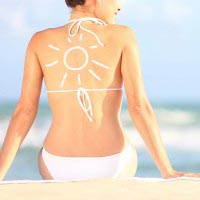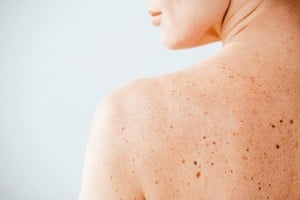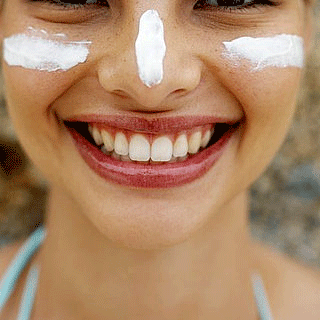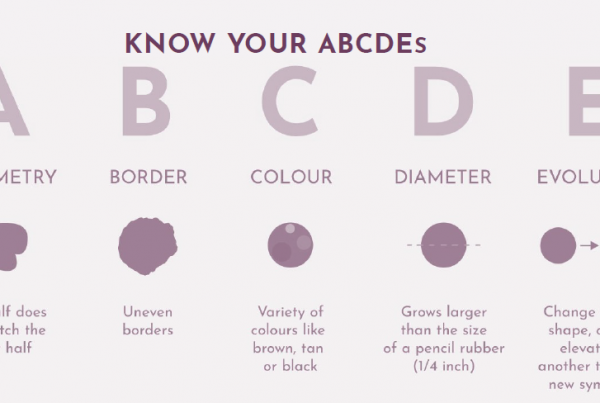
Who needs sun cream?
Everyone. Sun cream helps prevent skin cancer by protecting your skin from the sun’s harmful ultraviolet (UV) rays. All of us can get skin cancer, regardless of age, race or gender. Around 150,000 people are diagnosed with non melanoma skin cancer each year in the UK (we think the number could be higher as we know the numbers are under reported).
What sunscreen should I use?
We recommend that you use sunscreen that offers the following:
- Broad-spectrum protection (protects against UVA and UVB rays)
- SPF 30 or higher
- Water resistance, especially if doing sport or in and around the water
What does this mean when you’re at the shops? The label should have:
- a sun protection factor (SPF) of at least 30 to protect against UVB
- at least 4-star UVA protection
- If you have a history of sun damage and/or skin cancer, I recommend SPF50 and 5* UVA protection
How should I apply sun cream?
Most people apply less than half of the amount required to provide the level of protection indicated on the packaging. And people miss areas too, like the back and sides of the neck, temples, ears and behind the ears too.
There is a vast range of different product types available, so it is not possible to give a set amount that you should apply that is the same for all products. Individual manufacturers can provide further details specific to the application of their particular sunscreens.
For simplicity, when using lotions, as the bare minimum you should apply at least six full teaspoons (approximately 36 grams) to cover the body of an average adult.

Over half a teaspoon to the face, neck and backs of ears and over half a teaspoon to each arm. A full teaspoon to the back, the chest and each leg.
Applying less will reduce the protection to a higher degree than is proportionate – for example, only applying half the required amount can actually reduce the protection by as much as two-thirds.
Keep it simple – more is better and reapply every two hours, and immediately after swimming, perspiring and towel drying or if it has rubbed off.
Apply sun cream 15 to 30 minutes before going out in the sun to allow it to dry, and then again shortly after heading outdoors to cover any missed patches and to make sure you’re wearing a sufficient layer.
‘Water resistance’ is tested by the ability of a sunscreen to retain its sun protection properties following two 20 minute intervals (40 minutes total) of moderate activity in water.
But, up to 85 percent of a product can be removed by towel drying, so you should reapply after swimming, sweating, or any other vigorous or abrasive activity.
If the sun’s rays are reflected, the radiation can increase greatly: snow up to 85% increase, sand up to 17% increase, water up to 5% increase.
When should I use sun cream?
This one is another very simple message: every day if you go outside. The sun emits harmful UV rays year-round. Even on cloudy days, up to 80 percent of the sun’s harmful UV rays can penetrate your skin. It is especially important to apply SPF from March to September, when the UV rays are at a higher concentration.
Is a high number SPF better than a low number one?
Yes, but we recommend using a sunscreen with an SPF of at least 30, which blocks about 96% of the sun’s UVB rays. Higher-number SPFs block slightly more of the sun’s UVB rays, but no sunscreen can block 100% of the sun’s UVB rays.
But remember: high-number SPFs last the same amount of time as low-number SPFs. A high-number SPF does not allow you to spend additional time outdoors without reapplication.
How can I protect my baby or toddler from the sun?
If your baby is under 6 months, you should avoid exposing them to the sun’s rays. Sunscreen should be avoided if possible for babies younger than 6 months.
The best way to protect infants from the sun is to keep them in the shade. They should be dressed in long sleeves, pants, a wide-brimmed hat and sunglasses. Make sure they do not get overheated and that they drink plenty of fluids.
Parents of infants and toddlers 6 months and older may apply a broad-spectrum, water-resistant sunscreen with an SPF of 30 or higher to their children’s exposed skin that is not covered by protective clothing. Sunscreens that use the ingredients zinc oxide or titanium dioxide, or sunscreens made specially for infants or toddlers may cause less irritation to their sensitive skin.
Can I use the sun cream I bought last summer or do I need to purchase a new bottle each year?
We recommend that you wear sun cream every day that you go outside, even during winter months so a bottle shouldn’t last too long.
If you find a bottle that you have not used for some time, here are some guidelines (but always best to check with the manufacturer):
- sun cream retain their original strength for at least three years
- some sun cream include an expiration date. If the expiration date has passed, throw out the sunscreen.
- look for visible signs that the sunscreen may no longer be good. Any obvious changes in the colour or consistency of the product mean it’s time to purchase a new bottle.
Will using sunscreen limit the amount of vitamin D I get?
Using sun cream may decrease your skin’s production of vitamin D, although a recent study has suggested that even using a high SPF does not significantly reduce your Vitamin D levels. However, in the UK, as a nation, we get less UV exposure due to our climate, so having additional Vitamin D may be worth considering, especially if you limit your UV exposure. If you are worried that you are not getting enough vitamin D, you should discuss your options with your doctor. Many people can get the vitamin D they need from foods and/or vitamin supplements. This approach gives you the vitamin D you need without increasing your risk for skin cancer.
Are spray sunscreens safe?
The challenge with sprays is that it is difficult to know if you have used enough sunscreen to give you the correct coverage. When using spray sunscreen, make sure to spray an adequate amount and rub it in to ensure even coverage.
To avoid inhaling spray sunscreen, never spray it around or near the face or mouth. Spray the sunscreen into your hands and then apply it to these areas can help you avoid inhalation while also ensuring adequate coverage.
How do I treat sunburn?
It’s important to begin treating a sunburn as soon as possible and get out of the sun.We recommend treating a sunburn with:
- Cool baths to reduce the heat.
- Moisturiser to help ease the discomfort caused by dryness. As soon as you get out of the bathtub, gently pat yourself dry, leaving a little water on your skin. Then apply a moisturiser to trap the water on your skin.
- Hydrocortisone cream that you can buy without a prescription can help ease discomfort
- Aspirin or ibuprofen. This can help reduce the swelling, redness, and discomfort
- Drinking extra water. A sunburn draws fluid to the skin surface and away from the rest of the body. Drinking extra water prevents dehydration.
If your skin blisters, you have a second-degree sunburn. We recommend that you:
- Allow the blisters to heal untouched. Blisters form to help your skin heal and protect you from infection.
- If the blisters cover a large area, such as the entire back, or you have chills, a headache or a fever, seek immediate medical care.
- With any sunburn, you should avoid the sun while your skin heals. Be sure to cover the sunburn every time you head outdoors.



